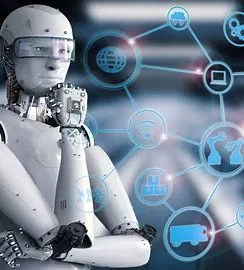Exploring the Benefits of AI-Powered Cybersecurity Education
The use of artificial intelligence (AI) in cybersecurity education is becoming increasingly popular as organizations strive to stay ahead of the ever-evolving cyber threats. AI-powered cybersecurity education offers a number of benefits that can help organizations protect their networks and data from malicious actors.
One of the primary benefits of AI-powered cybersecurity education is its ability to quickly identify and respond to potential threats. AI-powered systems are able to analyze large amounts of data and detect patterns that may indicate a potential attack. This allows organizations to take proactive measures to protect their networks and data before an attack occurs. Additionally, AI-powered systems can be used to detect and respond to malicious activity in real-time, allowing organizations to respond quickly and effectively to any threats.

Another benefit of AI-powered cybersecurity education is its ability to provide personalized training. AI-powered systems can be used to create customized training programs that are tailored to the specific needs of an organization. This allows organizations to ensure that their employees are receiving the most up-to-date and relevant training, which can help them stay ahead of the latest cyber threats.
Finally, AI-powered cybersecurity education can help organizations reduce their costs. By automating certain aspects of cybersecurity training, organizations can save time and money that would otherwise be spent on manual processes. Additionally, AI-powered systems can help organizations identify and address potential vulnerabilities before they become a problem, which can help reduce the costs associated with responding to a breach.
In conclusion, AI-powered cybersecurity education offers a number of benefits that can help organizations protect their networks and data from malicious actors. By leveraging AI-powered systems, organizations can quickly identify and respond to potential threats, provide personalized training, and reduce their costs. As the cyber threat landscape continues to evolve, AI-powered cybersecurity education will become increasingly important for organizations looking to stay ahead of the latest threats.
The Role of AI in Enhancing Cybersecurity Education
The use of artificial intelligence (AI) in cybersecurity education is becoming increasingly important as the world becomes more reliant on digital technology. AI can be used to help students learn about the latest security threats and how to protect against them. AI can also be used to create simulations and virtual environments that allow students to practice their skills in a safe and secure environment.
AI can be used to create virtual environments that simulate real-world scenarios. This allows students to practice their skills in a safe and secure environment without the risk of real-world consequences. AI can also be used to create simulations that allow students to practice their skills in a variety of different scenarios. This allows students to gain a better understanding of the different types of threats they may face and how to protect against them.

AI can also be used to create interactive learning experiences. AI can be used to create virtual classrooms where students can interact with each other and learn from one another. AI can also be used to create virtual mentors who can provide guidance and advice to students. This can help students gain a better understanding of the different types of threats they may face and how to protect against them.
AI can also be used to create automated assessments that can help students understand their progress and identify areas where they need to improve. AI can also be used to create personalized learning experiences that can help students learn at their own pace. This can help students gain a better understanding of the different types of threats they may face and how to protect against them.
Overall, AI can be used to enhance cybersecurity education by providing students with a safe and secure environment to practice their skills, creating interactive learning experiences, and providing automated assessments. AI can also be used to create personalized learning experiences that can help students learn at their own pace. By using AI to enhance cybersecurity education, students can gain a better understanding of the different types of threats they may face and how to protect against them.
How AI is Transforming Cybersecurity Education
The use of artificial intelligence (AI) in cybersecurity is rapidly transforming the way we approach the field. AI is being used to detect and respond to cyber threats more quickly and accurately than ever before, and it is revolutionizing the way we educate the next generation of cybersecurity professionals.
AI-driven cybersecurity education is helping to bridge the gap between the skills needed to protect organizations from cyber threats and the skills that students are learning in traditional cybersecurity courses. AI-driven cybersecurity education is helping to create a more comprehensive and effective approach to teaching cybersecurity.
AI-driven cybersecurity education is helping to create a more comprehensive and effective approach to teaching cybersecurity. AI-driven cybersecurity education is helping to bridge the gap between the skills needed to protect organizations from cyber threats and the skills that students are learning in traditional cybersecurity courses. AI-driven cybersecurity education is helping to create a more comprehensive and effective approach to teaching cybersecurity.
AI-driven cybersecurity education is helping to create a more comprehensive and effective approach to teaching cybersecurity. AI-driven cybersecurity education is helping to bridge the gap between the skills needed to protect organizations from cyber threats and the skills that students are learning in traditional cybersecurity courses. AI-driven cybersecurity education is helping to create a more comprehensive and effective approach to teaching cybersecurity.
AI-driven cybersecurity education is also helping to create a more personalized learning experience for students. AI-driven cybersecurity education is helping to create a more personalized learning experience for students by providing them with tailored learning experiences that are tailored to their individual needs and interests. AI-driven cybersecurity education is also helping to create a more interactive learning experience for students by providing them with real-time feedback and guidance.
AI-driven cybersecurity education is helping to create a more comprehensive and effective approach to teaching cybersecurity. AI-driven cybersecurity education is helping to bridge the gap between the skills needed to protect organizations from cyber threats and the skills that students are learning in traditional cybersecurity courses. AI-driven cybersecurity education is helping to create a more comprehensive and effective approach to teaching cybersecurity.
AI-driven cybersecurity education is helping to create a more secure future for organizations and individuals alike. AI-driven cybersecurity education is helping to create a more secure future by equipping students with the skills and knowledge they need to protect organizations from cyber threats. AI-driven cybersecurity education is also helping to create a more secure future by helping to create a more secure workforce that is better equipped to handle the ever-evolving cyber threats.
The Impact of AI on Cybersecurity Education in the Future
The impact of artificial intelligence (AI) on cybersecurity education in the future is expected to be significant. AI is already being used to detect and respond to cyber threats, and its use is expected to increase in the coming years. As a result, cybersecurity education must evolve to keep up with the changing landscape.
AI can be used to detect and respond to cyber threats more quickly and accurately than humans. This means that cybersecurity professionals must be trained to understand how AI works and how to use it to protect their networks. AI can also be used to automate certain tasks, such as scanning for vulnerabilities and responding to threats. This will allow cybersecurity professionals to focus on more complex tasks, such as developing strategies to protect against future threats.
In addition, AI can be used to analyze large amounts of data to identify patterns and trends in cyber threats. This will allow cybersecurity professionals to better understand the nature of cyber threats and develop more effective strategies to protect against them.
Finally, AI can be used to simulate cyberattacks and test the effectiveness of security measures. This will allow cybersecurity professionals to develop more robust security systems and better prepare for future attacks.
Overall, the use of AI in cybersecurity education is expected to have a significant impact on the future of cybersecurity. AI will allow cybersecurity professionals to detect and respond to threats more quickly and accurately, automate certain tasks, analyze large amounts of data, and simulate cyberattacks. As a result, cybersecurity education must evolve to keep up with the changing landscape.
Examining the Challenges of AI-Based Cybersecurity Education
The use of artificial intelligence (AI) in cybersecurity is becoming increasingly prevalent, and with it comes the need for a new type of cybersecurity education. AI-based cybersecurity education presents a unique set of challenges that must be addressed in order to ensure that students are adequately prepared to face the ever-evolving threats of the digital world.
One of the primary challenges of AI-based cybersecurity education is the need for students to understand the complexities of AI algorithms. AI algorithms are often highly complex and require a deep understanding of mathematics and computer science in order to be properly understood. This can be a daunting task for students who may not have a strong background in these areas. Additionally, AI algorithms are constantly evolving, making it difficult for educators to keep up with the latest developments.
Another challenge of AI-based cybersecurity education is the need for students to understand the ethical implications of using AI in cybersecurity. AI algorithms can be used to detect and respond to cyber threats, but they can also be used to invade the privacy of individuals or organizations. It is important for students to understand the potential implications of using AI in cybersecurity and to be able to make informed decisions about when and how to use it.
Finally, AI-based cybersecurity education must also address the need for students to understand the legal implications of using AI in cybersecurity. AI algorithms can be used to detect and respond to cyber threats, but they can also be used to violate the law. It is important for students to understand the potential legal implications of using AI in cybersecurity and to be able to make informed decisions about when and how to use it.
AI-based cybersecurity education presents a unique set of challenges that must be addressed in order to ensure that students are adequately prepared to face the ever-evolving threats of the digital world. By understanding the complexities of AI algorithms, the ethical implications of using AI in cybersecurity, and the legal implications of using AI in cybersecurity, students can be better equipped to make informed decisions about when and how to use AI in cybersecurity.







